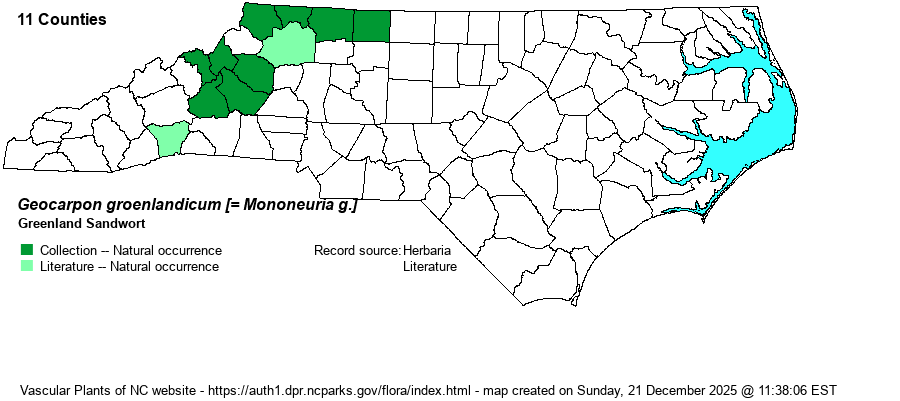| Author | (Retzius) E.E. Schilling. | |
| Distribution | This is a mostly montane species, ranging over the northern and central Mountains, south to Henderson County. It also occurs in the northwestern Piedmont but only on the higher monadnocks. Specimens from Forsyth County are from granitic flatrocks at low elevation and are G. glabrum.
This is a Northern species, with a very disjunct range. It ranges from eastern Canada south to NY, and then again from western VA to western NC (and adjacent TN). | |
| Abundance | Uncommon in the northern Mountains, but rare and local elsewhere, though it can be numerous in the small habitats in its range. This is a State Threatened species. | |
| Habitat | This species occurs at the higher elevations of the Mountains, mainly over 3000 feet, on exposed rock outcrops. These can be rocky summits or granitic domes, both on the margins of smooth outcrops or around crags and cliffs. It is usually found around acidic rocks. | |
| Phenology | Blooms from May to October, and fruits soon after flowering. | |
| Identification | This is a very low, mat-forming herb, with flowering stems only reaching 2-3 inches tall. The lower parts of the stems contain an abundance of paired, opposite leaves, but these are narrow and about 1/2-inch long. The flowering stalks contain only a few pairs of leaves. In this species, there are about 3-7 flowers on a given plant, at the tip of each branch, and each flower is about 2/3-inch across, with 5 white petals. Thus, for the tiny size of the plant, the flowers are relatively large. The very similar G. glabrum is not mat-forming, but has slender stems to about 6 inches tall, about 9-15 flowers per plant, but the flowers are smaller, barely 1/2-inch across. In the southern mountains and southern Piedmont is G. uniflorum, which is erect but has very short stem leaves (barely 1/8-inch long at best). When in bloom, this is a "cute" plant, almost moss-like with sizable white flowers. | |
| Taxonomic Comments | The species was formerly in the genus Arenaria in most of the last century, then was shifted to Minuartia. Some references, including Weakley (2018), have moved it to Mononeuria. And, in 2022, Schilling moved most of the genus now to Geocarpon. Weakley (2022) has followed this latest move -- certainly not the last!
| |
| Other Common Name(s) | Greenland Stitchwort, Mountain Sandwort | |
| State Rank | S2 | |
| Global Rank | G5 | |
| State Status | T | |
| US Status | | |
| USACE-agcp | | |
| USACE-emp | | |

